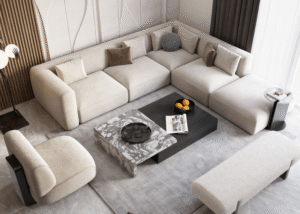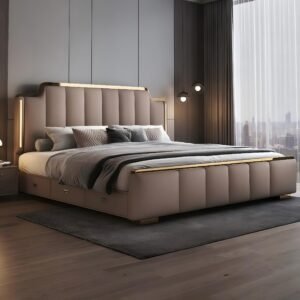Kitchen cabinets are put to the test every day—daily wear and tear, spills, and the occasional bump and scrape are the norm. Therefore, choosing durable materials is key to ensuring they remain beautiful and functional for years. To ensure durability and style coexist, these materials must be able to handle the mess of life while enhancing the kitchen’s atmosphere. Today, CS Home has sorted out the most durable kitchen cabinet materials for you—including solid wood, plywood, MDF, and more—to help you make a wise choice. Ready to build a durable kitchen? Let’s explore these tough materials, their advantages, and how to choose the best one for you!
Top Durable Materials for Kitchen Cabinets
Durability is more than just toughness, it also includes resistance to moisture, scratches, and deformation. Here are the best materials for 2025:
Solid Hardwood: A Classic and Sturdy Choice
Solid hardwood—like oak, maple, or cherry—tops the list for its strength and longevity. With proper care, hardwood cabinets can last for decades while showing off their natural beauty.
Main features:
- Strength: Hardwood is scratch-resistant and not easy to dent, with a long service life, making it an ideal choice for high-frequency kitchens.
- Variety: Common hardwood species: oak, maple, cherry and walnut, which can be customized as needed.
- Repairability: Scratches or dents on the surface of hardwood can be easily repaired by sanding and repainting, making maintenance very convenient.
- Adaptability: Beautiful and diverse, adaptable to traditional and modern styles
- Durability: Naturally dense and tough, dent-resistant, and withstands high-frequency use. Sealed finish increases moisture resistance.
Disadvantages:
- High price: It is more expensive than other materials.
- Maintenance required: Regular maintenance is required to prevent warping or moisture.
Best application scenarios:
Suitable for large kitchens with framed Shaker cabinets + U-shaped spacious spaces, homeowners who pursue classic design and expect long-term durability, which can fully display the texture and texture of wood grain.
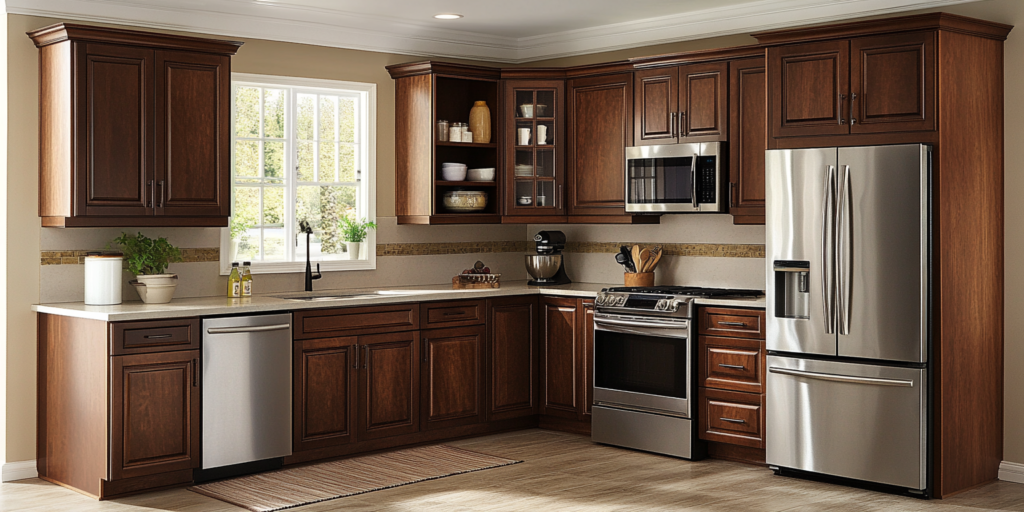
Plywood Board: Reliable and Affordable
Plywood is often used as the main material for cabinets. It is made of multiple layers of veneer and provides excellent durability at a low price. It is favored for its structural integrity and high cost performance.
Main features:
- Stability: Plywood can resist shrinkage, warping and cracking, and is resistant to deformation, cracking and moisture;
- Strength: High-grade plywood used for cabinets can provide excellent support for doors and drawers.
- Lightweight: Lighter than hardwood, easier to install.
- High cost performance: Affordable and durable, suitable for a variety of finishes
- High compatibility: Compatible with a variety of veneers and finishes, easy to customize design.
Disadvantages:
- The edges need additional processing to avoid burrs.
- Delamination may occur if exposed to excessive moisture for a long time.
Best application scenarios
Plywood cabinets are ideal for homeowners with limited budgets but value durability. They have good moisture resistance and are especially suitable for frameless cabinets, L-shaped or small kitchens.
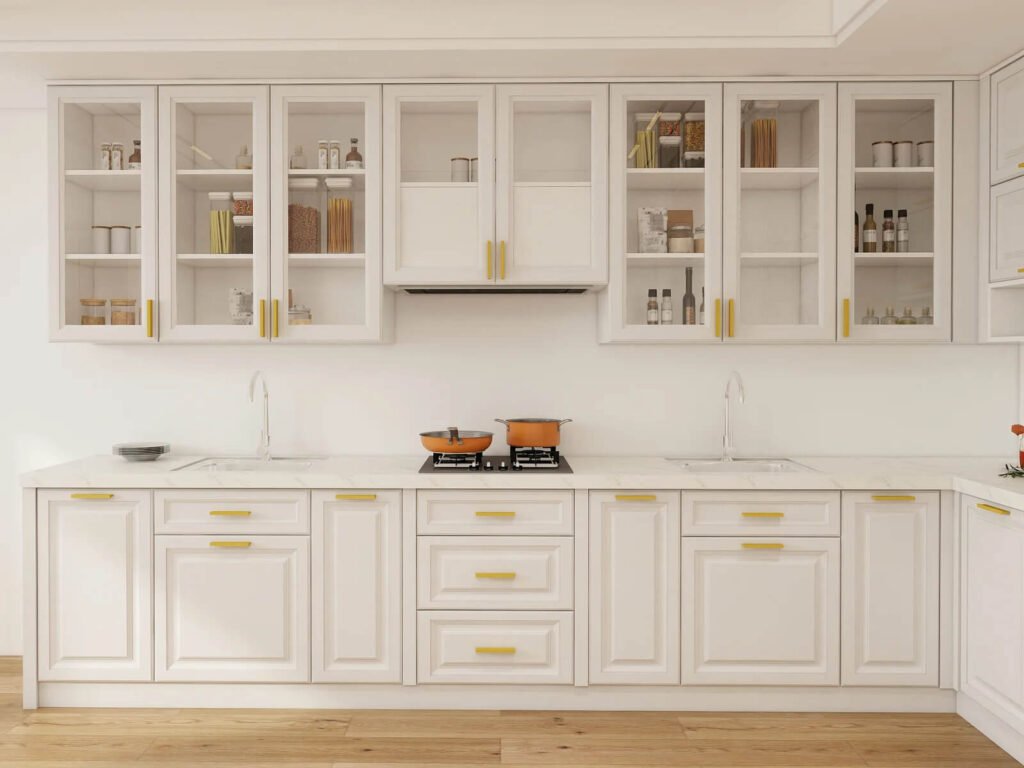
Medium Density Fiberboard (MDF): Economical and Versatile
MDF is an engineered wood made of compressed wood fibers. It is popular for its smooth surface and wide adaptability, making it a budget-friendly and durable choice.
Main Features
- Smooth surface: MDF provides a seamless surface, which is ideal for painting or veneer applications.
- Consistency: Unlike natural wood, MDF has no grain irregularities.
- Stability: Dense and uniform, resistant to deformation and cracking, not prone to warping or cracking; suitable for painted finishes
- Low cost: Affordable, smooth surface, easy to paint or veneer.
Disadvantages
- It is easily damaged by water when not sealed.
- Durability is slightly lower than hardwood and plywood.
Best Use Scenarios
MDF is suitable for homeowners who pursue modern or minimalist designs, and its durability can be improved when combined with high-quality finishes. Suitable for painted Shaker cabinets, dry right-angle layouts.

Stainless Steel: Modern and Indestructible
Although stainless steel cabinets are less common in residential kitchens, they are highly regarded in commercial kitchens for their sturdiness, durability and modernity.
Main Features
- Strength: 314# stainless steel, strong hardness, rust-proof, dent-resistant, easy to clean, heat-resistant, waterproof, fire-resistant, impact-resistant and corrosion-resistant, designed for high-intensity use.
- Sanitary: Non-porous surface effectively prevents bacterial growth and is easy to clean.
- Modern Aesthetics: Perfect for industrial or modern style kitchens.
- High Stability: Extremely durable and low maintenance.
Disadvantages
- High cost and heavy material.
- Limited design style options compared to wood cabinets.
Best Application Scenarios
Stainless steel cabinets are suitable for modern flat cabinets with islands or right-angle designs. Suitable for kitchens that require high durability and low maintenance requirements, especially for homeowners pursuing a stylish and minimalist style.
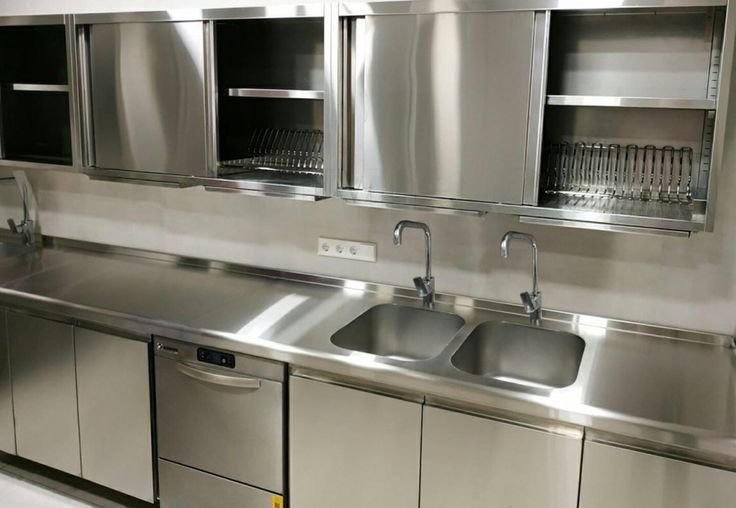
High-Pressure Laminate (HPL): Affordable and Enhanced Durability
High-Pressure Laminate is an advanced version of melamine, made with higher pressure bonding layers for greater durability, making it ideal for heavily used kitchens.
Key Features
- Durability: Highly resistant to scratches, stains, moisture, and impact.
- Design Options: A wide range of styles, with a variety of textures, colors, and patterns to choose from.
- Long-lasting: Durable, looks great after years of use.
- High Cost-effective: Low cost, easy to clean and maintain.
Disadvantages
- Slightly more expensive than regular melamine.
- Difficult to repair if damaged.
- Not high-end; easy to chip if edges are not sealed well.
Best Uses
HPL cabinets are suitable for frameless or flat cabinets, L-shaped kitchens, and are the best choice for homeowners who value durability, especially kitchens that are used frequently.
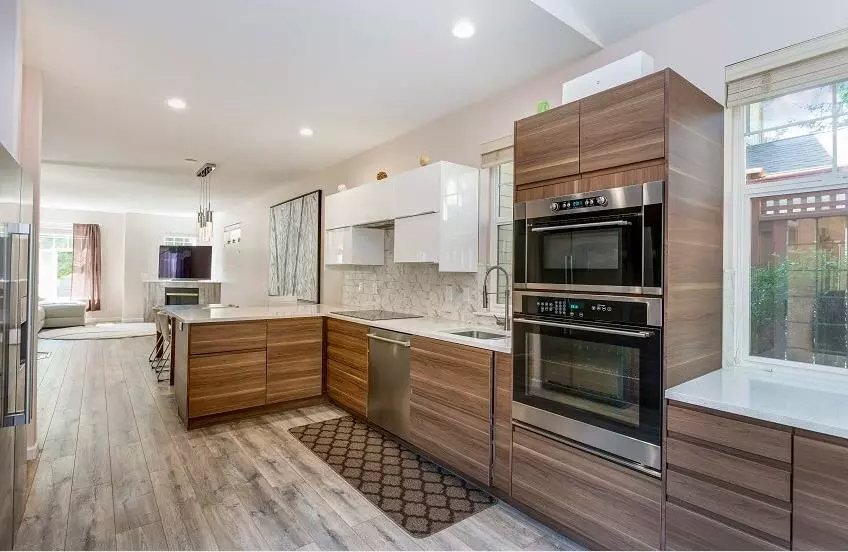
Melamine board: durable and easy to clean
Melamine board fuses resin-coated paper to particleboard or MDF to provide a solid finish.
Main features
- Durable surface: scratch-resistant, stain-resistant, resistant to slight moisture, scratches and heat.
- Various styles: Available in a variety of colors and textures, including imitation wood finishes.
- Easy to maintain: The surface does not easily absorb stains and is easy to clean.
- Low cost: Low cost and durable, low maintenance requirements.
Disadvantages
- Poor water resistance; edges need to be sealed, and edges may peel over time.
- Cannot be renovated after damage.
Best application scenarios
Suitable for Shaker cabinets, dry L-shaped kitchens, melamine is very suitable for kitchen cabinet designs that pursue easy maintenance and economical.
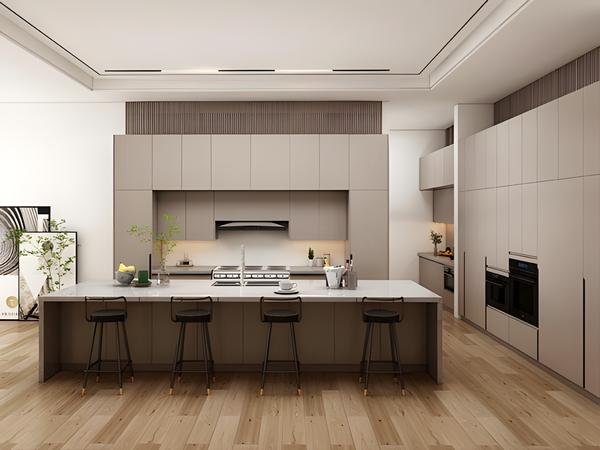
Why these materials stand out in 2025?
- Strength: Hardwood and stainless steel rank high in toughness.
- Moisture resistance: Plywood, HPL, and stainless steel are best able to handle spills.
- Affordability: MDF, melamine, and thermoplastic films offer uncompromising durability and low cost.
- Sustainability: Hardwood and plywood with eco-friendly sealants follow the green trend.
How to choose your durable materials?
To ensure maximum durability and performance of your cabinet materials, focus on the following factors:
- Budget: Balance cost and quality based on your needs.
- Kitchen environment: Choose moisture-resistant materials for humid or high-use kitchens.
- Maintenance needs: Choose materials that match your preferences, such as low maintenance or regular maintenance.
- Aesthetic appeal: Let the material style complement the overall kitchen design.
- Reliable cabinet suppliers: Reliable and professional kitchen cabinet suppliers can help you find the best cabinet materials. Here, CS Home has compiled 120 TOP cabinet manufacturers – https://www.pakitchen.com/top-120-kitchen-cabinet-companies-in-the-united-states-of-america/
Summary
In 2025, the most durable kitchen cabinet materials—like solid hardwood, plywood, and stainless steel—deliver lasting strength and style. Whether you value toughness, affordability, or a modern look, there’s a material for you. At CS Home, we’re here to help. Ready to create a kitchen that will stand the test of time? Contact us today to create your perfect space together!
When choosing a kitchen cabinet material, durability is key to ensuring a long-term return on your investment. Whether you value toughness, affordability, or a modern look, there’s a material for you. At CS Home, we’re here to help. Ready to upgrade your kitchen cabinets? Contact us today to create your perfect space together with our designers!

